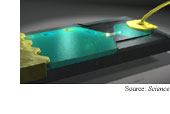|
NEWS
|
Cell logic
A prototype molecular computer uses the logic
of ordinary computers to detect proteins and other molecules
inside human kidney cells. The biomolecular device could
lead to diagnostics and treatments for cancer and other
diseases. (A
Universal RNAi-based Logic Evaluator That Operates in
Mammalian Cells, Nature Biotechnology, published
online May 21, 2007)
One electron at a time
 Zap an electrode attached to an infinitesimal
speck of semiconductor material that's capable of trapping
one or a few electrons and the device spits out a single
electron. The single-electron source could be used to
generate quantum bits for quantum computers. (An
On-Demand Coherent Single-Electron Source, Science,
May 25, 2007)
Zap an electrode attached to an infinitesimal
speck of semiconductor material that's capable of trapping
one or a few electrons and the device spits out a single
electron. The single-electron source could be used to
generate quantum bits for quantum computers. (An
On-Demand Coherent Single-Electron Source, Science,
May 25, 2007)
Super fantastic thermal plastic
A prototype electronic display made from a mix
of metal nanoparticles and plastic uses embedded wires
to heat the material, which reversibly generates colors.
The bendable, paper-like display could be used for signs
and portable electronic devices. (Paperlike
Thermochromic Display, Applied Physics Letters,
May 21, 2007)
Virus memory
Individual viruses attached to tiny specks of
semiconductor material can serve as nonvolatile memory
elements. The hybrid material could lead to inexpensive
methods of manufacturing memory chips for digital cameras
and other electronic devices. (Microscale
Memory Characteristics of Virus-Quantum Dot Hybrids,
Applied Physics Letters, May 21, 2007)
Blowing bubbles
Blowing bubbles from solutions of nanowires or
nanotubes turns out to be a simple and inexpensive way
to produce thin films with aligned and evenly distributed
arrays of nanowires or nanotubes. The technique could
be used to make flexible displays and other electronic
devices. (Large-Area
Blown Bubble Films of Aligned Nanowires and Carbon Nanotubes,
Nature Nanotechnology, published online May 27,
2007)
Stretchy silicon
A method of printing ultrathin ribbons of high-quality
silicon on plastic surfaces yields simple integrated circuits
that can stretch and bend without breaking. The method
could eventually lead to high-performance flexible electronic
devices. (Bendable
Integrated Circuits on Plastic Substrates by Use of Printed
Ribbons of Single-Crystalline Silicon, Applied
Physics Letters, May 21, 2007) |
FEATURES
|
View
from the High Ground: ICL's John Pendry
Physics as machine tool, negative refractive
index, metamaterials, shattered wine glasses, higher capacity
DVDs, scientific backwaters, risk perception and practice,
practice, practice.
|
How
It Works: Quantum computing: qubits
Photons, electrons and atoms, oh my! These particles are
the raw materials for qubits, the basic building blocks
of quantum computers. |
|
 |
News RSS feed 
Blog RSS feed 
Bookshelf RSS feed

New: TRN's
Internet Services
TRN's Jobs Center
|
| |
|
| |
|
| |
"Physics
is to the rest of science what machine tools are
to engineering. A corollary is that science places
power in our hands which can be used for good or
ill. Technology has been abused in this way throughout
the ages from gunpowder to atomic bombs."
- John Pendry, Imperial College London |
|
| |
|
| |
Thanks
to Kevin from
GoldBamboo.com
for technical support |
|

